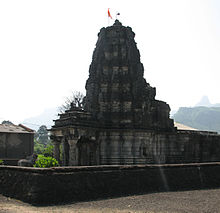| This section needs expansion. You can help by adding to it. (January 2022) |

Hemadpanti Sculpture (also spelled as Hemadpanthi) is an architectural style, named after its founder, the prime minister Hemadpant (1259-1274 CE) of the court of Seuna Yadavas of Devagiri. Hemadpant was a scholar, diplomat, and minister in the court of the Yadava dynasty of Devagiri, serving under King Ramachandra and his successor, Singhana II, during the 13th century. He contributed much to literature, administration, and architecture and authored works like "Chaturvarga Chintamani," a comprehensive treatise on Ayurveda and administration.
The Hemadpanti style of architecture is characterized by the locally available black stone and lime. Masonry is therefore an important characteristic of these temples. The structure was created without using any mortar by locking stones using the technique of tenon and mortise joints. Notable features include intricate stone carvings, sculpted pillars, and grand entrances. Temples and other structures built in this style often blend religious, cultural, and functional elements, reflecting the skill and artistry of the period. The outer walls of these temples are built in a star shape. It is in this star-shaped plan that the outer walls come to have a zigzag design. This creates a noteworthy effect of alternating light and shadow. Some noteworthy buildings include the temples in Pandharpur, Aundha Nagnath, and the Vijapur city walls, the Gondeshwar Temple at Sinnar Maharastra and the stunning Daitya Sudan temple (Lunar).

Hemadpanth is also credited for the development of the Modi (मोडी) script, which was the "cursive" style of Marathi writing, in which moving from one character to the next minimizes lifting the pen from the paper for dipping in ink.
Modi was the official script of communication and documentation from the 13th century to the 1960s, when it was discontinued and replaced with the Balbodh style to bring uniformity. Many Marathi people today can remember their grandfathers signing in Modi script.
Architectural elements
This building style was formed during the 13th Century in Maharashtra, and incorporated black stone and limestone, which were readily available. It also got the status of World Heritage Site.
Narsimha Temple Anji Nru. Dist Yavatmal, Maharashtra
| This section does not cite any sources. Please help improve this section by adding citations to reliable sources. Unsourced material may be challenged and removed. (February 2019) (Learn how and when to remove this message) |
- Khandoba Mandir, Beed.
- Gondeshwar temple, Sinnar
- Hembadpanti Mahadev Mandir Sakegaon, Sakegaon, Chikhali, Buldhana
- Markanda Mahadev, Chamorshi
- Tulja Bhavani
- Bhagwant Temple, Barshi
- Aundha Nagnath Temple
- Vitthal Temple, Pandharpur - but little early work remains. There is also a small temple of Shri. Vitthal, which is as old as the main Vitthal Mandir, in Isbavi area of Pandharpur known as Wakhari Va Korti Devalayas and also known as Visava mandir.
- Palasnath Mandir, Indapur, Pune, now partially submerged in back waters
- Bhimashankar Mandir
- Nagra Temple, Gondia
- Yamai Mandir, Mahalung, near Akluj
- Narsimha Mandir, Partur, near Aurangabad
- Shri Mallikarjun Mandir, Achaler
- Mankeshwar temple, Zodage, Tal. Malegaon, Dist. Nashik, Maharashtra, India.
References
- "Gondeshwar Temple". Maharashtra Bhraman. 2013-08-14. Retrieved 2022-05-14.
- "Hemadpanti Mahadev Mandir Sakegaon". www.onefivenine.com. Retrieved 2022-05-14.
External links
| Architecture of India | |
|---|---|
| Types | |
| By state | |
| By city | |
This article related to an architectural style is a stub. You can help Misplaced Pages by expanding it. |